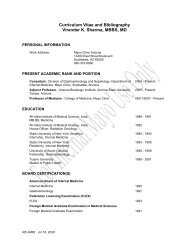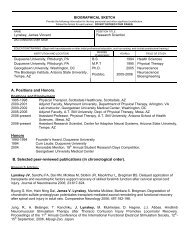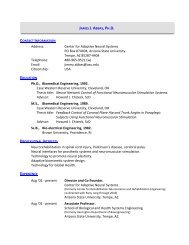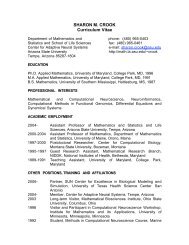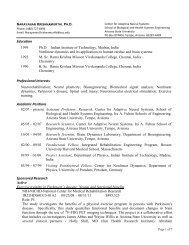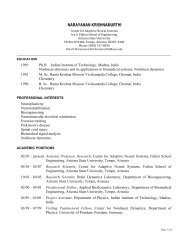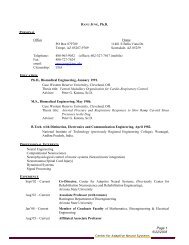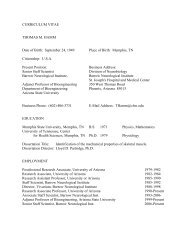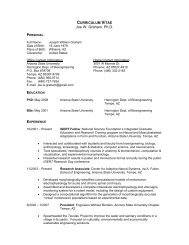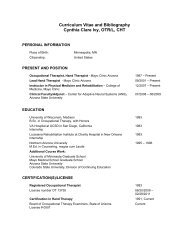ASU FC S 04 - Center for Adaptive Neural Systems - Arizona State ...
ASU FC S 04 - Center for Adaptive Neural Systems - Arizona State ...
ASU FC S 04 - Center for Adaptive Neural Systems - Arizona State ...
You also want an ePaper? Increase the reach of your titles
YUMPU automatically turns print PDFs into web optimized ePapers that Google loves.
Faculty & Research News<br />
NSF CAREER award winner seeks to<br />
understand environmental effects of biosolids<br />
Backyard gardeners<br />
have long valued the<br />
benefits of composting.<br />
Since the 1970s, the<br />
EPA has recommended<br />
recycling a wastewater<br />
treatment product, or<br />
biosolids, to use as a<br />
fertilizer on agricultural<br />
land. However, an EPAsponsored<br />
National<br />
Academy of Sciences<br />
report on biosolids<br />
recently concluded that<br />
the data in which the<br />
EPA has to say biosolids<br />
are safe <strong>for</strong> agricultural<br />
use was outdated.<br />
“Of the options available, what really<br />
makes the most sense is putting biosolids on<br />
agricultural land,” said Fulton School assistant<br />
professor of civil and environmental<br />
engineering, Jordan Peccia. “On the other<br />
hand, biosolids are full of heavy metals and<br />
they do have pathogens in them—not all of<br />
them die. Right now, there is insufficient evidence<br />
out there to say whether it’s a public<br />
health safety issue or not.”<br />
Now, Peccia’s research will provide the first<br />
detailed environmental analyses of biosolidstreated<br />
agricultural land. Peccia recently was<br />
the recipient of a five-year $400K NSF<br />
CAREER Award <strong>for</strong> early career development,<br />
given to researchers deemed most likely to<br />
become the academic leaders of the 21st century.<br />
After biosolids are placed on agricultural<br />
fields, environmental <strong>for</strong>ces such as wind<br />
gusts, storms or plowing can aerosolize the<br />
biosolids into a plume that can reach downwind<br />
populations. “The trick is how you<br />
sample the wind,” said Peccia. “How much<br />
does the wind have to blow to get particulate<br />
matter in the air?” To address this question,<br />
Peccia has designed a special wind tunnel,<br />
which he can place directly on the ground to<br />
determine the effect physical properties such<br />
as soil type and wind speed have on<br />
aerosolizing the particulate matter.<br />
Jordan Peccia’s research characterizes microbial populations in<br />
biosolids using DNA microarrays.<br />
In order to characterize the amount and<br />
types of microorganisms present in the air,<br />
Peccia relies on liquid impingers that,<br />
through a high vacuum, suck in air samples.<br />
Peccia’s group also determines the amount of<br />
heavy metals and other chemical contaminates<br />
that may be present.<br />
From pilot studies, Peccia determined that<br />
the amount of wastewater indicator bacteria<br />
in the air increases as much as ten-fold on a<br />
windy day. Using the wind tunnel combined<br />
with state-of-the-art DNA microarray analysis<br />
will ultimately confirm the identity of<br />
aerosolized microorganisms and provide evidence<br />
to support or not support the hypothesis<br />
that pathogens can become aerosolized<br />
microbial soil pathogens.<br />
“DNA microarrays are like a computer chip<br />
with sequences of DNA from all the different<br />
pathogens and antibiotic resistance genes,”<br />
said Peccia. Peccia’s group can take a soil and<br />
air sample, isolate the DNA, and use the<br />
microarray to match the test soil DNA against<br />
the DNA of known microbial pathogens.<br />
Peccia hopes that from the results of these<br />
studies, he can gain a true understanding of<br />
the physical and environmental properties<br />
that contribute to biosolids aerosolization to<br />
help ensure that the practice is safe and sustainable.<br />
Additionally, he will take his results<br />
directly into the curriculum to use as case<br />
studies <strong>for</strong> environmental engineering courses<br />
and expand offerings to the non-scientist by<br />
focusing on environmental issues.<br />
Peccia also plans to expand the international<br />
scope of the project through continued<br />
collaborations with the University of Baja<br />
Cali<strong>for</strong>nia in Mexico that look at water issues<br />
in developing countries. “I want to take care<br />
of my own research group and provide them<br />
with opportunities to be more well-rounded,<br />
other than just doing research in the lab,”<br />
said Peccia.<br />
For more in<strong>for</strong>mation, see<br />
http://www.fulton.asu.edu/civil/<br />
Faculty/Peccia.htm<br />
IRA A. FULTON SCHOOL OF ENGINEERING – SPRING 20<strong>04</strong> 21



